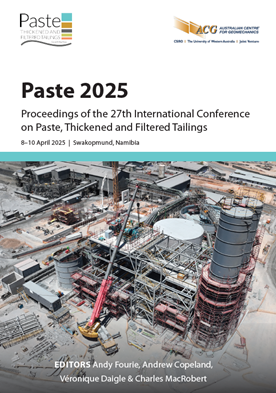Empirical performance validation of a large-scale Reactorwell™ feedwell

|
Authors: Viduka, SM; Nugter, B |
DOI https://doi.org/10.36487/ACG_repo/2555_10
Cite As:
Viduka, SM & Nugter, B 2025, 'Empirical performance validation of a large-scale Reactorwell™ feedwell', in AB Fourie, A Copeland, V Daigle & C MacRobert (eds), Paste 2025: Proceedings of the 27th International Conference on Paste, Thickened and Filtered Tailings, Australian Centre for Geomechanics, Perth, pp. 153-164, https://doi.org/10.36487/ACG_repo/2555_10
Abstract:
Over time it has been demonstrated that computational fluid dynamics (CFD) modelling can be a powerful tool to enhance the design and operation of feedwells in thickeners. Several benefits realised are optimised flow dynamics, particular in size scale-up; enhanced flocculation; reduced flocculant consumption; reduced equipment size; energy efficiency; and adaptability to variable conditions. As compared to physical testing, numerical modelling can offer insights that are often inaccessible through traditional measurement techniques. The relatively low resource commitment allows for rapid evaluations of numerous design concepts used to address the wide-ranging needs of the industry. However, there are concerns regarding the validity of assessment results. These need to be addressed through accurate numerical implementation, proper interpretation of feedwell dynamics during the modelling stage, and empirical validation. This paper demonstrates how CFD was used to design a feedwell against pre-established plant process variables with subsequent validation during plant operation. The empirical verification was performed on a 13 m diameter feedwell which was integrated into a feed system upgrade for a 65 m copper tailings thickener. The evaluation consisted of the following methods: tracer dye drone imagery; dilution flow rate measurement; internal mapping of solids concentration; both underwater footage of dilution flow and discharged floccules. Findings confirm that the predicted design aligns well with reality. Overall, the retrofitted feed system fulfilled the updated requirement of a higher throughput. It did so by adopting a slightly larger feedwell (12 m to 13 m) with new technology and a break tank. Despite the higher throughput a significant outcome was an average reduction in flocculant usage by 30% while improving operational stability and reducing the thickener bottleneck. Subsequently, and at the time of testing a reduction of 62% from previous highs was present and more permanently achieved with inclusion of a digital process control strategy.
Keywords: feedwell, flocculation, thickening, computational fluid dynamics, experimentation
References:
Bedell, D, Fawell, P, Slottee, S & Schoenbrunn, F 2015, ‘Thickening’, in RJ Jewell & AB Fourie (eds), Paste and Thickened Tailings ‒ A Guide, 3rd edn, Australian Centre for Geomechanics, Perth, pp. 113–136.
Fawell, PD, Farrow, JB, Heath, AR, Nguyen, TV, Owen, AT, Paterson, D … Usher, SP 2009, ‘20 years of AMIRA P266 “improving thickener technology” — how has it changed the understanding of thickener performance?’, in R Jewell, AB Fourie, S Barrera & J Wiertz (eds), Proceedings of the 12th International Seminar on Paste and Thickened Tailings, Australian Centre for Geomechanics, Perth, pp. 59–68,
Hassanzadeh, V, Henriksson, B & Bolookhuu, O 2024, ‘Enhancing the performance of a tailings thickener following the upgrade of the feed system’, Tailings 2024: Proceedings of the 10th International Conference on Tailings Management, Gecamin, Santiago.
Viduka, SM & Henriksson, B 2021, ‘Thickener feedwell internal trough slurry distribution method’, in AB Fourie & D Reid (eds), Paste 2021: Proceedings of the 24th International Conference on Paste, Thickened and Filtered Tailings, Australian Centre for Geomechanics, Perth, pp. 71–78,
© Copyright 2025, Australian Centre for Geomechanics (ACG), The University of Western Australia. All rights reserved.
View copyright/legal information
Please direct any queries or error reports to repository-acg@uwa.edu.au
View copyright/legal information
Please direct any queries or error reports to repository-acg@uwa.edu.au
